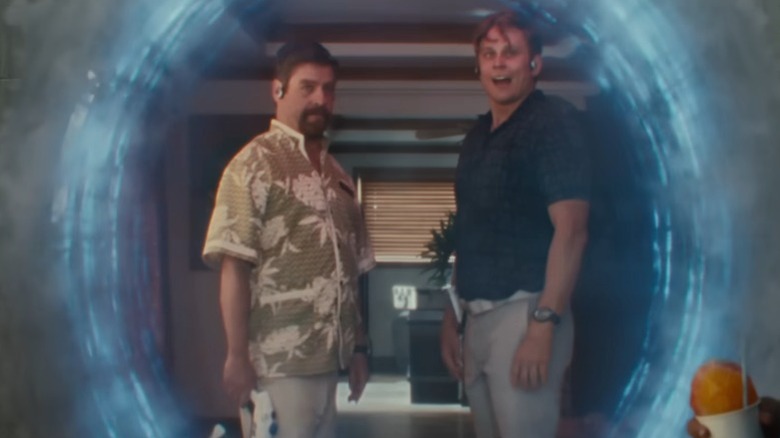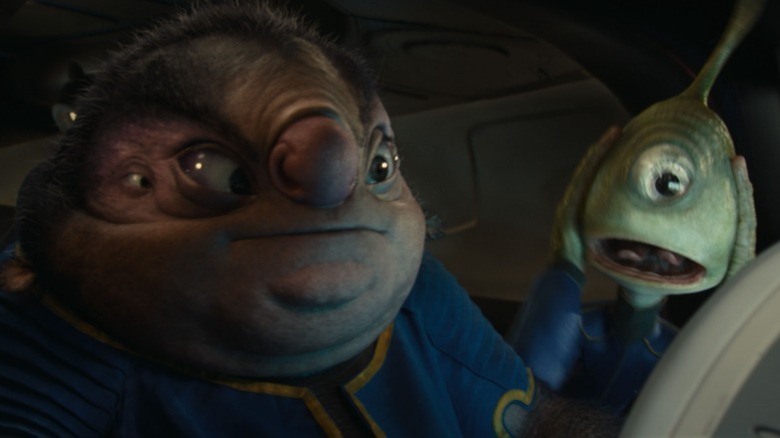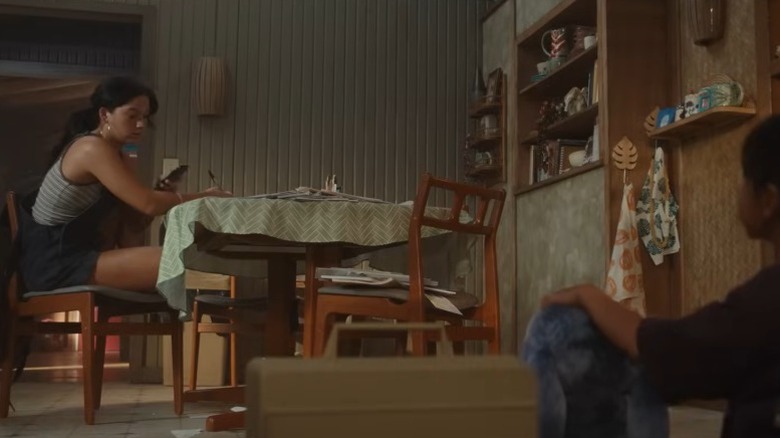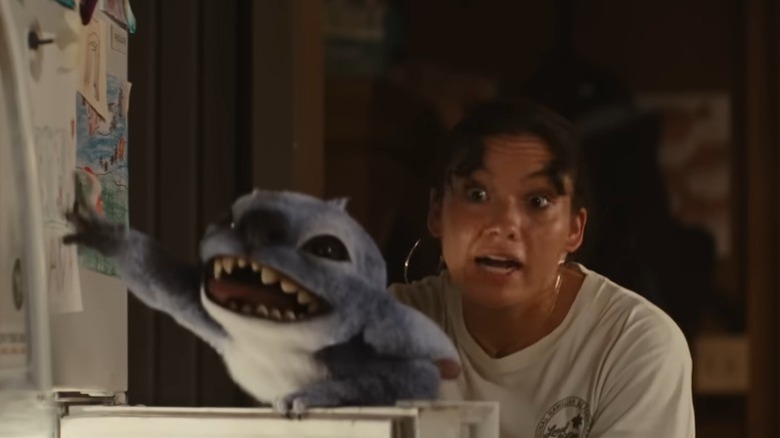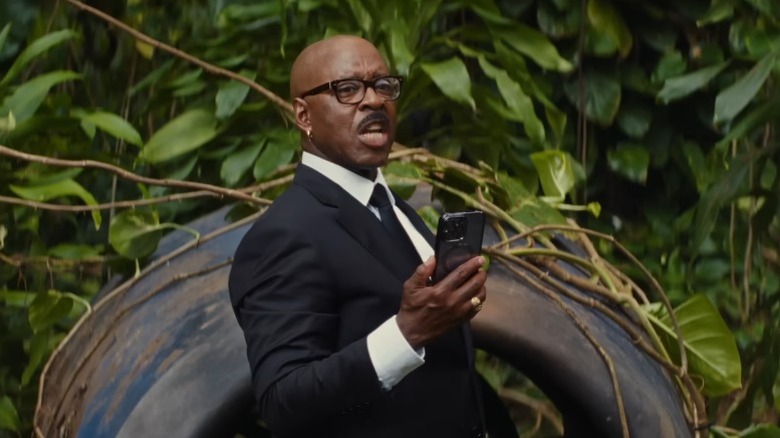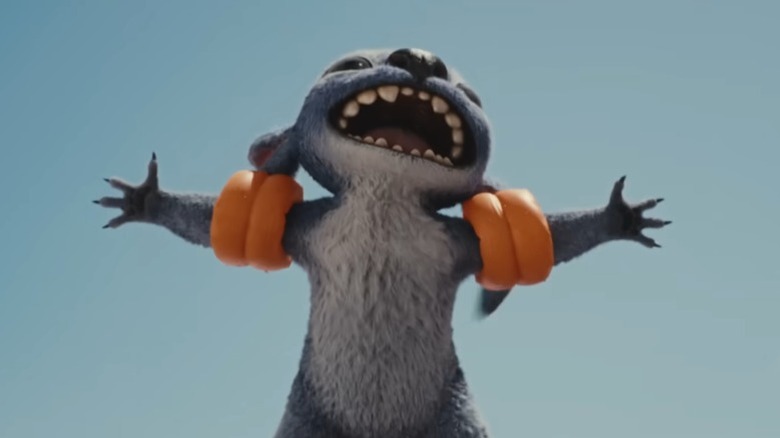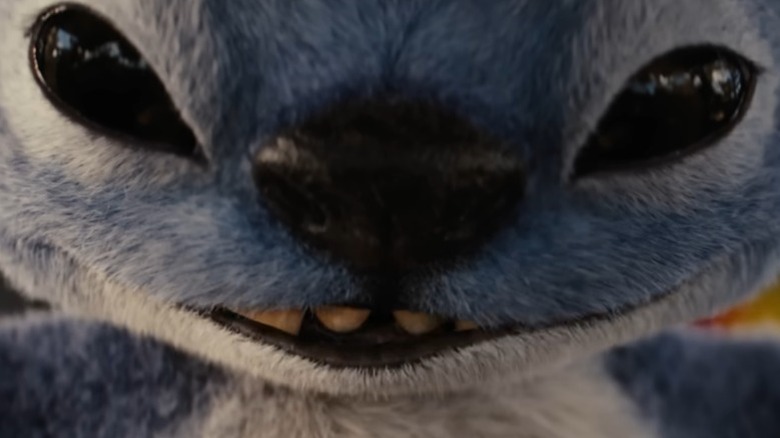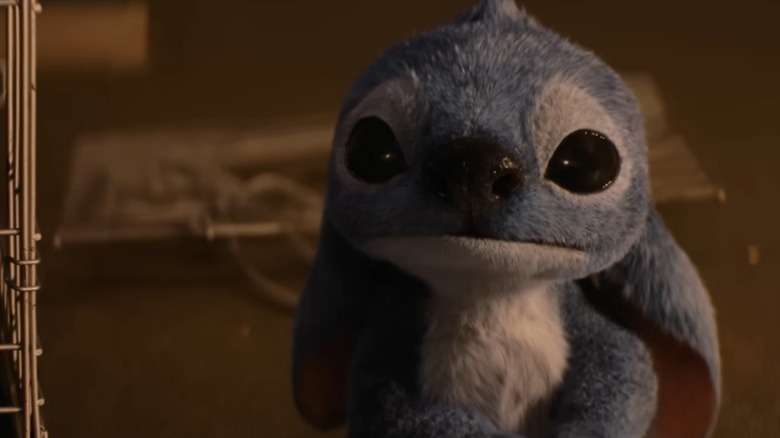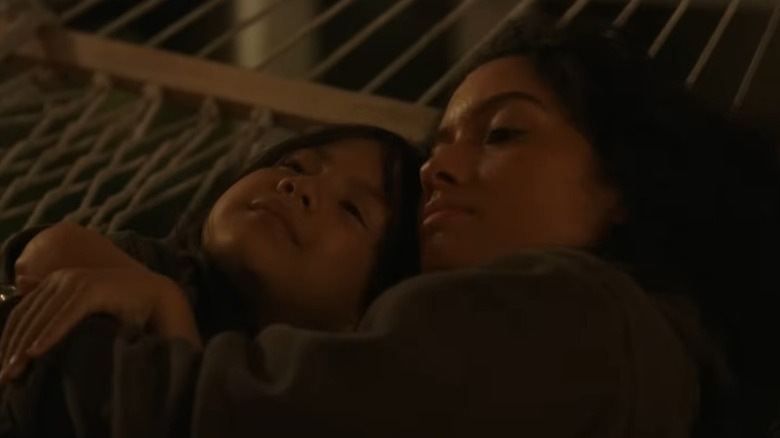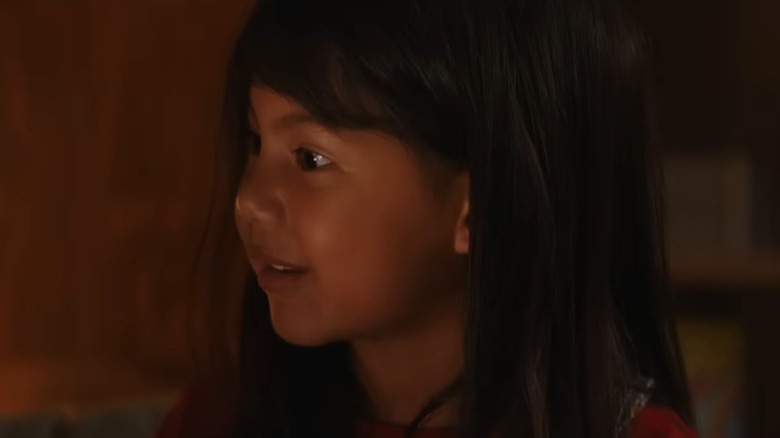Things Only Adults Noticed In The Live-Action Lilo & Stitch Movie
Contains spoilers for "Lilo & Stitch"
Directed by Dean Fleischer Camp, the live-action "Lilo & Stitch" remake is on track to become one of Disney's biggest box office hits in years, having already raked in hundreds of millions of dollars at the global box office in just a few days. Fans all over the world are poring over small details in the new film and discussing its similarities and changes from the beloved 2002 original.
One thing that's plain to see is that, despite the controversial changes that have come to be expected of these remakes, this new "Lilo & Stitch" carries on the original's tradition of being a kid-friendly movie with plenty of serious, mature themes that only adults notice, coming through most of all in the story of Nani's (Sydney Elizebeth Agudong) effort to provide for Lilo (Maia Kealoha) following the death of their parents. On that note, here are a few particularly interesting elements that grown-up viewers may pick up on in the new movie.
Jumba and Pleakley's changed appearances reflect the film's bid for realism
In the original "Lilo & Stitch" as well as its various TV and straight-to-video continuations, the world operates under a sort of don't-overthink-it cartoon logic, where there's no need for Pleakley and Jumba to fret too much over how to blend into human society. They just put on human clothes, some wigs and headpieces, maybe some makeup, and they're set. No one questions the fact that a four-eyed giant and a one-eyed tentacled creature are casually walking around Kauai.
In the live-action "Lilo & Stitch," conversely, both Jumba (Zach Galifianakis) and Pleakley (Billy Magnussen) disguise themselves by way of holographic devices that reproduce the exact likenesses of two humans they pass by on the street. It may well have been partly a cost-cutting measure to reduce the amount of CGI in the movie, but the change also tracks conceptually with the movie's ethos. If the aim was to retell "Lilo & Stitch" as a story occurring in the "real world," there's no way Jumba and Pleakley in slapdash human disguises wouldn't have looked out of place. In a way, that seemingly minor change encapsulates the whole aesthetic raison d'être behind making a live-action "Lilo & Stitch" in the first place.
The vetoing of Pleakley in drag speaks to real-world culture wars
One of Pleakley's defining characteristics in all animated "Lilo & Stitch" media is his habit of favoring women's clothing while donning the aforementioned cartoonishly superficial "human" disguises. In the 2025 "Lilo & Stitch," meanwhile, not only does Pleakley never wear any female garments in his original alien form, but his holographic disguise is 100% male, and crosses no significant gender lines with his choices of wear.
The change has fanned speculation about whether Disney may have felt that, in 2025, featuring a character in de-facto drag would have been too politically risky. Said speculation was intensified when director Dean Fleischer Camp posted a TikTok in which he states that he "tried" featuring Pleakley in drag, even showing concept art of the character in his signature wig-muumuu combo.
The original Pleakley is not transgender — the whole joke is that he's detached from human social norms and therefore doesn't feel the need to conform to gender-appropriate clothing. But, in light of Disney having recently scrapped a trans storyline from the Pixar series "Win or Lose," it seems possible that higher-ups felt it safer to do away with any gender nonconformity whatsoever in the live-action "Lilo & Stitch." If true, it's a rather dispiriting sign of the times, and of how much things have regressed since 2002.
Despite the realism, Lilo is given a super-sized bedroom
In the original "Lilo & Stitch," Lilo's bedroom reflects the depiction of the Pelekais' residence as a pretty typical working-class Hawaiian family home. There's enough room in it for a child's bed, a medium-sized rug, and some toys and small furniture. Lilo can prance around comfortably in it, but it's not a huge bedroom.
Live-action Lilo's suite, however, is positively enormous. Even accounting for the different proportions of live production design compared to cel animation, her bedroom is depicted as being at least three times larger than the original — enough for massive amounts of decor, a bathroom, and a round carpet that's bigger than her bed and still doesn't even take up a third of the available space on the floor.
This suggests one of two things: Either "Lilo & Stitch" is implying that Lilo moved to her parent's bedroom after their passing, or the set design team opted to just chuck realism out the window in order to make Lilo's room more aspirationally comfy.
Nani is a more emotionally neglectful sister this time around
The original Nani is temperamental and cranky, with a generally snarky, seen-it-all attitude about Lilo's antics and a huge reluctance to accept Stitch for most of the movie. But she is never shown as being emotionally distant. Not only is their dynamic constantly warm and loving, but the film frequently indicates that Nani understands her little sister, is deeply attuned to Lilo's vibrant inner life and accustomed to her various idiosyncrasies, and genuinely cares about Lilo's interests.
The live-action version of Nani, meanwhile, appears to be more emotionally affected by the weight of her responsibilities, and behaves a lot more like a teenager in over her head — which includes an overall absent-mindedness and lack of interest in Lilo, often treating her as something of an annoying burden. Examples include her not accompanying Lilo to the animal shelter, paying zero attention to Stitch's (Chris Sanders) record-playing bit, and a general lack of patience and understanding towards Lilo in most of their scenes together. The live-action "Lilo & Stitch" angles for a more emotionally thorny version of Nani — one who still loves her sister, but is somewhat understandably exhausted from having to put up with a volatile six-year-old every day, and may not be the most proficient caretaker.
Nani is also a lot more skeptical about the concept of Ohana
The quote "Ohana means family, and family means nobody gets left behind or forgotten" is among the best-remembered soundbites not just of the original "Lilo & Stitch" but of all animated cinema in the 21st century. It's a philosophy Lilo, Nani, and eventually Stitch take to heart and practice with every fiber of their being — it even winds up being the thing that mellows Nani's heart and convinces her to let Lilo keep Stitch despite his tendency to wreak havoc.
The fight with Nani in which Lilo evokes the concept of Ohana to argue in Stitch's favor is maintained in the live-action adaptation, but with a very major difference. This time, Nani rolls her eyes and sighs in exasperation when Lilo brings up Ohana, and then proceeds to add that "All that stuff sounds so nice ... but that is not reality." Instead of the more idealistic slant of the original, in which Nani sticks to Ohana as a bedrock that gives her the strength to make ends meet for herself and Lilo, the live-action "Lilo & Stitch" depicts a Nani who is a lot more cynical and skeptical about how far Ohana is actually able to go in practical life.
Cobra Bubbles' status as a current CIA employee changes the dynamic
The gist of Cobra Bubbles as a character in the original "Lilo & Stitch" is that he defies expectation: His brooding, serious, suited-up look and hyper-efficient demeanor aren't exactly what we'd expect of a social worker, and, by the same token, his genuine concern and empathy for Lilo and Nani underneath the tough exterior comes as a continually renewed surprise. Things are clarified a bit when the film's ending reveals him as a former CIA agent who even once met the Grand Councilwoman decades prior.
The live-action remake rejiggers Bubbles' (Courtney B. Vance) characterization by establishing him immediately as an active CIA agent, and then having him pose as the new superior of social worker Mrs. Kekoa (Tia Carrere, who played Nani in the original "Lilo & Stitch") for the purpose of getting closer to Stitch and facilitating capture. That occupational shift alters the movie's dramatic dynamic significantly. Now, Bubbles is not actually invested in Lilo and Nani's wellbeing at first, and only becomes attached to the duties of his social worker position after spending time with the Pelekais. This change makes Bubbles a less reactive character than he was in the original and gives him an arc of his own — arguably at the cost of some of the sense of surprise and specificity the character was originally imbued with.
David's relationship with Nani now feels more like a supportive platonic friendship
David is a kind and supportive sweetie pie in both versions of "Lilo & Stitch," but he doesn't play coy about his romantic intentions with Nani in the original. As soon as we see him for the first time at the luau, he's already asking Nani out — and being gently rebuffed by her, who explains that between caring for Lilo and working to secure a living, she doesn't have time for dating. Even so, there's clear romantic tension between the two, and it persists throughout the whole film. By the time they're made an item in the closing credits album montage, a blossoming relationship has already been fully implied.
By contrast, there's not much of an implied romantic courtship between David (Kaipo Dudoit) and Nani in the 2025 "Lilo & Stitch." Now reconfigured as the grandson of Tūtū (Amy Hill), David is more of a bumbling platonic friend to Nani. He does awkwardly attempt to flirt with her in their first on-screen interaction, but Nani doesn't reciprocate at all, and, though the scene where Lilo reassures David that Nani likes his "butt and fancy hair" is kept, it no longer occurs in the context of Nani's rejection of David. In fact, though David is always around to help out, we barely see him and Nani interact. He's firmly established as Ohana to Nani and Lilo, but not necessarily a romantic suitor — at least not until the closing credits montage depicts them kissing.
The surfing scene now includes a Titanic reference
The live-action iteration of the "Hawaiian Roller Coaster Ride" scene, in which Stitch experience surfing for the first time, is significantly altered in the live-action movie. In the original, he tags along with Lilo, Nani, and David a bit timidly, and only gradually opens up enough to be able to see the beauty in the ocean and enjoy himself. In the new version, meanwhile, Stitch is a bit scared at first, but is otherwise excited about the prospect of surfing from the get-go.
In fact, his excitement culminates in a pop culture reference that was not present in the original Lilo & Stitch: As Nani and Lilo stand on the surfboard behind him, Stitch walks to the tip of the board and stretches out his arms, in a position reminiscent of the most iconic line from "Titanic," Jack Dawson's (Leonardo DiCaprio) "I'm the king of the world!" When "Lilo & Stitch" came out in 2002, that 1997 scene was still relatively recent, and not quite as firmly established as canonical pop iconography as it is today. Seen in 2025, however, with decades' worth of references to that scene in movies and TV shows, it's impossible to miss the allusion.
The hose scene also throws in a spaghetti Western reference for good measure
The "king of the world" pose isn't the only fresh cinema reference in the live-action "Lilo & Stitch." The scene in which Stitch grabs hold of a water hose in a cold drink stand at the resort where Nani works also features Stitch in a distinctive pose that should strike a chord with any Western fans in the audience.
Stitch faces down Lilo with a wry grin, brows furrowed, and feet slightly apart, and the movie shows his focused face in close-up — followed by a close-up of his hand on the "holster" — as he prepares to fire the hose at Lilo as if it were a gun. That small comedic beat is, of course, a reference to spaghetti Westerns and their tense, highly-stylized standoffs. In addition to being a cute bit of loopy cartoon logic that evokes the spirit of the original "Lilo & Stitch?" and its "Godzilla" parody bit — how would Stitch even know about Westerns in order to know to imitate them? — the scene also amusingly nods to Stitch's status as an incorrigible yet charismatic outlaw.
There's an understandable calculus to making Jumba the villain
Come to think of it, the character of Dr. Jumba Jookiba was always a pretty big swing, all things considered. A mad scientist and criminal depicted menacingly, antagonistically, and near-villainously for most of the runtime, only to shift his priorities out of sheer loyalty to Stitch and then transform himself into a sympathetic, even heroic character, he was a surprisingly full-blown anti-hero for a kid-oriented Disney movie. And he never actually got any comeuppance for his crimes against the galaxy.
It makes a kind of pragmatic sense that Disney would opt to retrofit him into a more traditional character in the remake, by making him an outright villain and depicting him being arrested at the end. A troublemaking blue fur ball is one thing, but a criminal who gets away with it? And joins the good guys' side with little more than a spontaneous change in attitude? It really does seem like too much for the safety-favoring Disney of 2025. And the choice to strip Jumba of his over-the-top Eastern European accent, too, is probably a matter of trying to ruffle as few feathers as possible.
Stitch's guilt isn't just a result of feeling out of place
In both the animated and live-action versions of "Lilo & Stitch," Stitch's guilt and shame over wrecking things for Lilo and Nani eventually get the better of him; both movies' third acts find Stitch isolating himself, away from his new family, because he believes that they're better off without him.
In both versions, there's a social subtext to that conflict. Stitch is, at worst, just behaving like a particularly irascible pet, and it speaks to a fundamental systemic dysfunction that Nani's guardianship of Lilo should be threatened so decisively by his mostly harmless antics just because they make it harder for her to make a good first impression on potential employers.
But the live-action film emphasizes the extent to which Stitch's sense of inadequacy is just him taking the blame for a situation he didn't create. It speaks volumes that his crisis of conscience begins at the hospital, while watching Nani struggle to cover Lilo's treatment without health insurance — the movie even drives it home by removing the line in which David blames Stitch for Nani and Lilo's inability to "make it work." In essence, the situation in which Nani and Lilo find themselves is designed by the system to be fundamentally untenable; Stitch is just the catalyst for a crisis that would have happened either way under the existing socioeconomic system.
The changes to Nani's story significantly impact the movie's themes
The original "Lilo & Stitch" made a point of depicting Nani as an "average" working-class young woman, whose life is not primarily defined by her career. Like hundreds of millions of people in the real world, every new job she takes is just a way to make ends meet — and her life isn't any less interesting or dignified for that. The live-action "Lilo & Stitch," conversely, depicts Nani as a former child prodigy with big dreams, whose vocation as a marine biologist is smothered by her obligations as Lilo's caretaker.
It's a big change, to say the least, and every viewer will probably respond to it differently. The choice to make Nani a more ambitious and driven heroine, in line with Belle's (Emma Watson) expanded backstory in the live-action "Beauty and the Beast," does give Nani a layer that she didn't have in the original film, and makes her a more fully-rounded person outside of her relationship with Lilo. But her decision to leave Hawaii — and, by extension, Lilo — to attend college in California fundamentally alters the original film's firm defense of Nani and Lilo as a strong, loving family unit misunderstood by the state. In the live-action movie, Nani really isn't the best caretaker for Lilo, because, deep down, she doesn't want to be. It's little wonder that change has been leaving fans divided.
This film's version of Lilo seems a lot more emotionally healthy
If live-action Nani is burdened by living a life that isn't really the one she wants, live-action Lilo actually appears to be living a much more put-together life than her animated counterpart — at least as far as emotional processing is concerned. While the new movie's Lilo is as eccentric, lonely, constantly bullied, and desperate for a friend as the original Lilo, she also seems a lot more happy, stable, and mature.
Whereas the original Lilo had a much more abrasive personality, gave in to frequent fits of anger, tried to use voodoo to punish her friends, and constantly shifted between moods as a result of her still-fresh grief over her parents' passing, the live-action Lilo is actually taking things impressively well. She doesn't have anger fits, her fights with Nani are a lot more measured and rational, she seems pretty aware of what's going on around her and able to handle it all most of the time, she doesn't get angry at Stitch for jeopardizing her family's unity, and — most notably — she even goes so far as to encourage Nani to leave Hawaii in pursuit of her dreams. This is a version of Lilo that's much easier to picture fending for herself without her big sister around.

